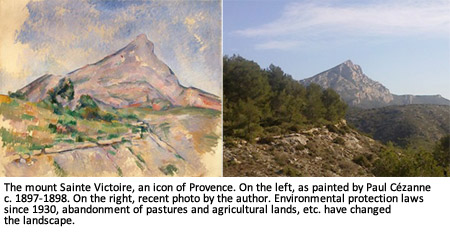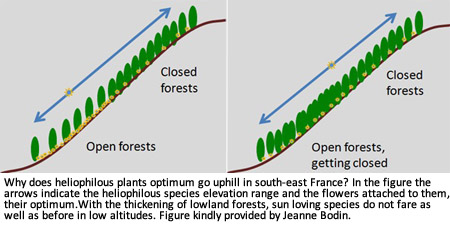
Statisticians call them confounding factors with reason. And that, my colleague Jeanne Bodin knows very well. In her previous workplace, the French National Institute of Agricultural Research, she studied the upward migration of plant species in the mountains of this region of France to see whether it was caused by climate change. And… it wasn't. Her work, directed by Jean-Luc Dupouey, was published in the Journal of Vegetation Science, and it actually received the journal's Editor’s Award for 2013.

The French National Forest Inventory provided the data for Jeanne Bodin’s study, data of good quality thanks to the standardised, consistent and well-documented methods used to obtain representative samples. The French National Inventory, in fact, uses stratified sampling, that is sampling from relatively homogeneous groups previously defined (ecological regions, forest types, administrative divisions and ownership types, in this case).
For example, one subgroup might correspond to a private conifer forest in the meridional calcareous chains in the department of Bouches du Rhone; and so on. In order to compare the evolution of vegetation with time, she used the data for two periods, the 1980s and the 1990s. Nearly 31,000 samples in total, about half and half for each period, taken between sea level and 2,500m and including data for almost 2,000 species of plants and mosses.
One of the problems of big data sets is that in order to extract interesting conclusions, it is often necessary to weed out the information that is not necessary to answer the question at hand (though it may be useful to answer other questions). Jeanne Bodin did this in several stages. To start with, of the almost 2,000 recorded species, just 1,137 had been observed in both time periods. For the next refining stage, she dealt with observer bias.
In vegetation surveys, observer bias is related to the fact that not all observers 'see' exactly the same number of species in a given area. In general, one would expect an experienced observer to 'see' more species – and more correctly identify them – than a less experienced one. For example, I might mistake one grass species for another very similar one. That wouldn't happen to my colleague. Also, some people are more meticulous than others. Some observers might overlook that tiny single plant in their sample, which they don't even know and would take them a long time to identify back in the lab. While others would identify each and every species to the subspecies level. Surely, these are extreme cases and the field surveyors of the French National Forest Inventory are well trained and meticulous in their job. Still, rare species can prove difficult to identify.
So, to get around the problem of observer bias, Jeanne Bodin used only species identified with high reliability. Then, she selected the species that were present in at least 50 samples in each time period in order to retain enough observations to fit a logistic model. With these models she estimated the elevation optimum for each species and time period – there was some more weeding out here of species without a statistically significant bell-shaped model or without an optimum in the studied elevation range. As a result, she ended up with a clean and neat data set for 175 species.
Using this data she observed a significant overall upward migration of 18m, 74 species shifting upwards with statistical significance and 18 downwards. The structure of vegetation also changed between the two time periods – young forests tend to grow and thicken after all – so that the proportion of open forest diminished from 37% to 19%. However, the change was more intense for lower elevations (below 1300m), which means that the behaviour of the data set restricted to closed forests could be different. Indeed, when she repeated the analysis for closed forests… Voilà! There wasn’t upward migration any more.

If uphill plant migration in the south-east France had been caused (mainly) by climate change, one would have expected similar results in both data sets. Since this was not the case, and other phenomena have affected vegetation in the region in the last decades, the explanation seems to lie somewhere else.
The analysis of biological and ecological traits showed that upward migrating species were mostly heliophilous (sun loving) woody plants of the early stages of vegetation succession. They grow well in open spaces, but when forests grow denser and shadowy, sun loving plants become rarer – like heliophilous English and Parisian tourists in a rainy Provence. Since forest closure was more intense in lower elevations, there are now less sun loving species in lowlands and as a result their optimum is somewhat higher up (see image on the right).
Acknowledgements
Thanks to Jeanne Bodin for her kind explanations and useful comments, and for providing one of the figures.
References
Bodin, J.; Badeau, V.; Bruno, E.; Cluzeau, C.; Moisselin, J.-M.; Walther, G.-R.; Dupouey, J.-L. (2013) Shifts of forest species along an elevational gradient in Southeast France: climate change or stand maturation. Journal of Vegetation Science, 24 (2), 269–283. DOI: 10.1111/j.1654-1103.2012.01456.x
Pärtel, M.; Chiarucci, A.; Chytrý, M.; Pillar, V. D. (2014) Silver Jubilee of the journal and complexity of global change. Journal of Vegetation Science, 25 (1), 1–3. DOI: 10.1111/jvs.12133




